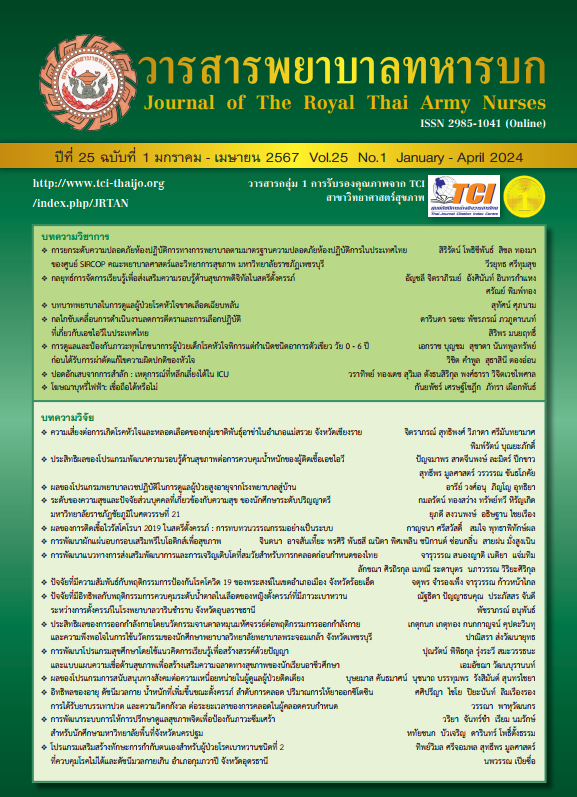Care and Prevention of Malnutrition in Pediatric Patients with Congenital Heart Disease of The Green Type. Newborns to 6 Years Old Before Undergoing Surgery to Correct Heart Abnormalities
Keywords:
Cyanotic congenital heart disease, malnutrition, caregiver of children with green type congenital heart diseaseAbstract
Cardiovascular disease in children is very important to their survival. Especially the group that has symptoms of cyanosis. The disorder results in hypoxia. From a study of statistics around the world, approximately 8 cases were found. per 1,000 live births from statistics in pediatric heart disease clinics Siriraj Hospital, in 2023, a total of 2,144 children were admitted for treatment and were diagnosed with malnutrition. 192 cases. This condition causes children to grow slowly and get tired easily because venous blood is mixed in the red blood that goes to the body. Normally, venous blood does not mix with red blood. As a result, the oxygen level is lower than normal. This group of children needs surgery. This method can be done from infancy. Some people have to wait for their cardiovascular characteristics, age, and body weight to be appropriate in order to have surgery to correct all abnormalities. While waiting for surgery at home, caregivers play a very important role in raising children to have a healthy body. Close to normal children as much as possible, reducing complications especially malnutrition.
This article aims to care for and prevent malnutrition in pediatric patients with congenital heart disease. Congenital cyanosis from birth to age 6 years before undergoing surgery to correct heart abnormalities. Aim for caregivers have knowledge and understanding Have the skills to properly care for children while waiting for surgery at home Moderators can manage nutrition appropriately To prevent complications and severe symptoms of the disease The aim is for these children. Have a body ready to undergo surgery to correct heart abnormalities and be in line with the doctor’s treatment plan.
Downloads
References
Chungsomprasong P, Jaturachaidech C. Pediatric cadiology siriraj hospital. 2017. Department of Pediatrics, Faculty of Medicine Siriraj Hospital. (in Thai)
Soiphet N, Intichoti N, Khrutmuang W, Suanpan N. Care for children with congenital heart disease to prevent respiratory tract infection. Journal of Health and Nursing Research. 2019 ;35(2): 26-37 (in Thai)
Soongswang J, Durongpisitkul K, Chanthong P, Vijarnsorn C. Adult congenital heart disease Transition from pediatric to adult heart care. 2014; A-plus Print. Faculty of Medicine Siriraj Hospital. (in Thai)
Chowdhury F, Hoque MM, Ali M, Hossain A. Comparison of growth in children with cyanotic and acyanotic congenital heart disease in a tertiary care hospital. Journal of Bangladesh College of Physicians and Surgeons 2018;36(2):64-9 (in Thai)
Somchue N, Sanasuttipun W, Srichantaranit A. The effect of a teaching program on knowledge and behaviors of caregivers to promote nutrition in children with acyanotic congenital heart disease. Journal of Nursing Science 2016; 34(3): 79-93. (in Thai)
Jintrawet U, Sen-Ngam K, Wangsachantanon T and Sripusanapan A. Roles of nurses on promoting nutritional status of children with congenital heart disease post cardiac surgery. Journal of Health and Food Creation. 2023; 1: 72-83 (in Thai)
Koonwiang E, Nuntapoonsub S, Khamphul W. Preoperative Care and Prevention of Complications in Pediatric Patients with Benign Congenital Heart Disease. Journal of The Royal Thai Army Nurses. 2023 ;24(2) : 67-7 (in Thai)
Downloads
Published
How to Cite
Issue
Section
License
Copyright (c) 2024 Journal of The Royal Thai Army Nurses

This work is licensed under a Creative Commons Attribution-NonCommercial-NoDerivatives 4.0 International License.
บทความหรือข้อคิดเห็นใดใดที่ปรากฏในวารสารพยาบาลทหารบกเป็นวรรณกรรมของผู้เขียน ซึ่งบรรณาธิการหรือสมาคมพยาบาลทหารบก ไม่จำเป็นต้องเห็นด้วย
บทความที่ได้รับการตีพิมพ์เป็นลิขสิทธิ์ของวารสารพยาบาลทหารบก
The ideas and opinions expressed in the Journal of The Royal Thai Army Nurses are those of the authors and not necessarily those
of the editor or Royal Thai Army Nurses Association.






